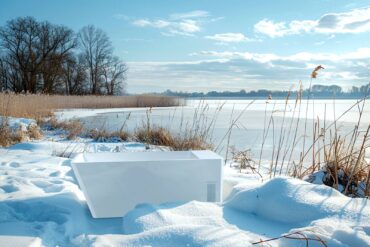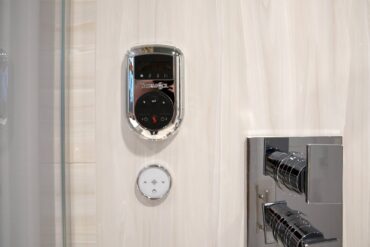
There is a lot to think about when designing and selecting materials for a bathroom project. As with any project, the first step is to define your needs, overall objectives and budget.
Most homeowners need better bathroom storage and more counter space, but this is just the tip of the iceberg. Busy lives and the pandemic have significantly changed how homeowners view their bathrooms and what they would like bathrooms “to do” for them, creating a shift from simple, utilitarian spaces to ones that emphasize features for aging-in-place and safety; spa-like amenities that enhance health and wellness; and sustainability for water, energy and material conservation.

The design trends and fixture innovations discussed here have the potential to reduce your morning grooming-routine chaos, your carbon and water footprint and your maintenance efforts — while delivering a spa-like experience every day for enhanced health and wellness. Whether your design and fixture selections are based on cost, sustainability or that sweet spot between cost and value, some of the suggestions below require a nominal investment while others may require more serious planning and budgetary consideration. Only you can decide which can bring value to your life and therefore justify the investment.
Health and Wellness
Everyone is aware of the health benefits of a good night’s sleep. So ask yourself, what is a good night’s sleep worth to you? Electric-resistant, heated floors and heated toilet seats can indirectly help you get better sleep. Though these are not new concepts, there has been significant improvement in these product categories over the past 10-plus years.

They may seem like luxuries, but for those who frequently wake in the night to use the commode, consider the benefit of not being brought to full consciousness by walking across a cold bathroom floor or sitting on a cold toilet seat. Homeowners with heated floors and toilet seats find they can fall back to sleep faster after a nighttime visit to the bathroom.
An added benefit of heated floors is that they dry out faster than those that are not heated, helping maintain good indoor air quality and reducing slip and fall risks. Additionally, in the event you fall in the bathroom and are unable to get up quickly, a heated floor can reduce the transfer of your body heat to the floor, mitigating further injuries. The added cost of heated floors will depend on the size of your bathroom, but it can range from a few hundred dollars to a few thousand.

Heated toilet seats are a common feature of bidet-style seats and toilets. Additional benefits derived from bidet-style seats include relieving constipation by relaxing the person’s body and promoting efficient elimination, reducing toilet paper consumption (your septic tank will thank you), minimizing the spread of germs and contagions, and maintaining dignity and independence for those with physical limitations (temporary or long-term) because they can operate these toilets without assistance from a caretaker.

You’ll find bidet-style seats can be adapted to your existing toilet for a modest investment, while bidet-style toilet models can run $1,700 – $9,000 depending on features and design. Two factors to consider when selecting a bidet style toilet or seat: Almost all models require an electrical outlet (and a surge protector). Disregard models where the controls are attached to the side of the seat — even if you can read the controls now, your depth perception will diminish with age and you will find it nearly impossible to read them in the future.

If you have municipal water or a community well, your water supply likely has chlorine in it. Warm water from showers naturally opens your pores, allowing unwanted chemicals to be absorbed through your skin and causing dry, irritated skin. Vaporized chlorine can also affect the lungs when shower steam is inhaled.
Filtered shower heads can remove chemicals such as chlorine from your shower water before it hits your body. Several manufacturers offer “filtered” shower heads that can trap chemicals and some contaminants in a replaceable filter. The filters have a six-month life on average and the heads can range in price from $30 to $165 (such as the Jolie touted by current influencers.) You can probably recoup your investment quickly due to the reduction of hair conditioner and body lotion used. One thing to consider is the aesthetics of the shower head; most are not particularly attractive, and no part of the filters are recyclable.

The Mayo Clinic has confirmed what the Finnish have known all along: Cold water plunging is good for your health. Cold plunging can reduce inflammation (great for addressing autoimmune diseases), decrease stress levels by reducing cortisol and increasing dopamine in the body, restore balance to your central nervous system and improve the look and feel of your skin.
Spas devoted to plunging are popping up all around the world, but those without access to large bodies of cold water or plunge spas didn’t have the ability to partake in this wonderful health benefit at home — until now. Valley Acrylics, a Canadian manufacturer of bathroom fixtures, has just debuted Element+, a plunge tub designed for residential installations. The tub is sleek and compact and is available in black or white with a price tag that can be justified by the health benefits received.

Combining Conservation with Health and Safety
Who doesn’t like a twofer? These bathroom products can enhance your health and bathing pleasure while reducing your water and energy consumption.
Like long hot showers? Consider incorporating a RainStick shower tower into your project. It recirculates filtered shower water and even has a technology that maintains the water temperature after it has been filtered. A RainStick shower system renders a 3-gallon-per-minute flow and will not set you back much more than a standard shower head, all guilt-free. Winner of numerous product awards, it is available online at rainstickshower.com.
Alternatively, a steam shower can provide deep, moist heat for maximum relaxation and other health benefits with minimum water and energy usage. Steam showers are incorporated into a standard shower with the requisite controls and steam port, providing two separate functions in one footprint. (Note: The motor for the steam shower must be in a conditioned space according to the manufacturer’s specified distance from the shower, not an attic or crawl space, and the shower enclosure must be sealed.)

Steam showers take very careful planning and can add several thousand dollars to your project budget to execute. But the benefits to your skin and sore muscles could potentially save you a bundle at the spa and is truly advantageous for people with certain autoimmune diseases.
Hate sending water down the drain while waiting for hot water? Solution: A recirculating pump installed with a programmable timer can save water and energy. Water is circulated through the existing pipes at predetermined times of day, delivering hot water to your kitchen faucet or shower seconds after you turn on the spigot rather than minutes and several gallons later. You can recoup your investment in a re-circ pump in just a few years, not to mention the time you will save not waiting for hot water.
Thermostatic valves are commonplace in Asia and Europe but strangely not so much in the USA. Thermostatic valves, unlike their pressure-balance brethren, give you the ability to control both the water temperature and volume (pressure) separately, effectively providing the option to customize your shower experience with respect to temperature and volume. However, the most significant benefit to a thermostatic valve is the ability to turn the water off, mid shower, to shave legs or brush teeth, with the confidence and comfort knowing that the water temperature will be the same when you turn it back on. This creates an opportunity to save a lot of water and reduce pressure on septic systems, as well as minimize scalding.

Spa-Like Features
If a spa-like experience is your jam, consider these design features and fixtures: Replacing a deck-mounted (drop-in) bathtub with a freestanding soaking tub can provide an updated look with more functionality.
From indoor plants to cat litter boxes, deck-mounted jet tubs have been used for many things other than bathing. One reason is that the water heaters in most homes are not sized to meet the needs of yesterday’s soaking tubs, leaving the bath half full and the rest of the household without hot water.

Further, many deck-mounted tubs have a monolithic presences, making the bathroom feel small and cramped. As a result, homeowners are turning to smaller, deeper freestanding soaking bathtubs with or without amenities such as heated back rests, effervescent air jets and more. They typically have a smaller footprint and require much less water to satisfactorily submerge the bather. Note: Freestanding tubs generally don’t meet the criteria of an aging-in-place bathroom.
Freestanding soaking tubs can run a wide price gamut depending on size, material and amenities. A very basic acrylic model will cost about $3,000 and go up from there, but this doesn’t include a Roman tub filler. Most freestanding tubs are best served by a floor-mounted tub filler, which can easily cost north of $2,000.

Wi-Fi connected shower controls, a digital shower valve mixer with technical enhancements, allows you to not only customize your bathing experience by shower head activation (assuming there is more than one shower head) but also the volume of water, temperature, steam, chroma therapy, music and aromatherapy. A great feature for aging-in-place and wheelchair users. These shower mixers can be activated by a cellphone, your home Wi-Fi system or manually. Although they are not complicated fixtures, they do need a fair amount of advanced planning, which renders their material and labor costs in the $2,000-$4,000 range.

Everyone wants to look their best and one way to achieve that is with an adjustable LED-lighted mirror. LED mirrors with variable light temperatures (Kelvin) allow you to select a light level that mimics the environment you are expected to be in, be it outdoors, in a brightly lit office or a dark and moody restaurant. Additionally, with LED mirrors that have light bars encompassing the perimeter of the glass, all the areas of your face and neck are sufficiently illuminated.

LED light mirrors are available at a variety of price points (recognize you are getting a twofer — a mirror and lighting in one product), from a few hundred dollars to a few thousand depending on size and features. Like most things in life, you get what you pay for and with many foreign imports, it is worth an investment in time to select one with a good warranty.
Aging in Place
Comfort-height toilets and decorative grab bars are the norm. Of the items mentioned above, bidet-style toilets, heated floors, LED mirrors with multiple Kelvin options and thermostatic valves are always good additions to a bathroom intended for aging in place. Here are a few more small investment items to consider: a built-in or fold-up bench, a hand-held shower head on a slide bar, light switches and receptacles with integrated night lights, lights built into a shower shampoo niche or wall to give visual continuity, and occupancy sensors that illuminate a space (near the floor) without requiring a switch.

Reduced Maintenance
Love the look of tile but hate the thought of cleaning grout? Solution: First, confirm that your tile mason uses a sealant-impregnated grout or a topical penetrating grout sealant. This will minimize soap scum buildup and mildew growth if, and only if, you use pH-neutral cleaners on your tile grout after installation. Any product that contains bleach or hydrogen peroxide can pit your grout, making it susceptible to harboring scum and promoting mold and mildew growth.
Do you loathe squeegeeing your shower glass but hate the mineral deposits so common on shower glass? You are not alone, which is why Airmada was born. Airmada is effectively a blow dryer for your shower. Warm air, generated by a concealed motor, is blown through waterproof ports embedded in your shower walls to dry your entire shower. It effectively removes moisture — along with the possibility of mold and mildew growth — reducing maintenance requirements and prolonging the life of your shower glass and tile grout. It also contributes to maintaining good indoor air quality. The drying process can take 30-45 minutes during the drying cycle and is somewhat loud, but it works well. This feature must be well-planned for and will add approximately $3,000 to your budget.

Water damage from leaking pipes and wasted water from running toilets and faucets can be both costly and a real nuisance. Consider installing a flow meter at the point where your water supply enters the home. This meter will detect if water is consistently flowing and will alert your mobile phone of the situation, potentially giving you ample time to save your home from water damage and your wallet from excessive water utility bills. Many homeowners’ insurance policies provide a discount for installing a leak detector, effectively paying for the peace of mind you will gain from your purchase.

Aesthetic Bathroom Trends
As with most rooms in a home, a beautiful design is all for not if the lighting is an afterthought. Consider the following lighting rules of thumb: Layer the lighting for all activities and moods. Bright bathroom lights first thing in the morning, especially if it’s still dark outside, is not a nice way to start your day. But high light levels are great when you’re cleaning. Consider where a dimmer might be employed to keep light levels low, both when initially starting your day and when ending it.

Second, for safety reasons, always have a light directly over the shower. If you like to read in the bathtub or on the commode, have a light directly above these fixtures, too. A dimmer for the water closet light is an excellent way to navigate to the commode in the middle of the night (if you don’t have a night light on your bidet-style toilet).

Motion-activated lighting under a wall-hung vanity or a vanity toe-kick is another way to navigate your way to the water closet in the middle of the night. If an LED mirror feels too modern for you, incorporating sconces on either side of a framed mirror, along with a recessed can light centered on the sink, will provide significantly better illumination for grooming and cleaning than a bar light over the mirror.
Bathroom plumbing, lighting and hardware finishes are seeing an upswing in mixed finishes such as black with brass or gold with wood. Biophilic design, which embraces textural, natural materials like wood, natural fibers, stone and plants, continues to trend strong, creating soothing color palettes. Green, in many shades, is also trending, as seen in cabinetry, tile and countertops.
With so many design and fixture options to consider, shortcut your decision process by consulting with an experienced bathroom design professional on your next project. Working with a seasoned professional can save you time and money and help you avoid disappointment when you discover that a fixture doesn’t meet current building codes.




































